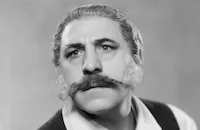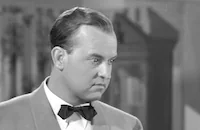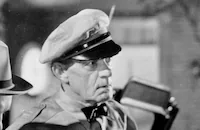The Crime of Dr. Forbes
Brief Synopsis
Cast & Crew
George Marshall
Gloria Stuart
Robert Kent
Henry Armetta
J. Edward Bromberg
Sara Haden
Film Details
Technical Specs

Synopsis
After his graduation from medical school, Michael Forbes accepts a position as the assistant to the renowned Dr. Eric Godfrey at the Jefferson Institute of Medical and Allied Sciences in New York. Michael works day and night for six months researching spondylitis-deformans, a disease which causes rigidity of the spinal column. After Michael meets Dr. Godfrey's young and attractive wife Ellen, Dr. Godfrey encourages Michael and Ellen to use his opera tickets because he won't be in town for the performance. On the way to the opera house, Ellen's chauffeur has an accident outside a small Italian restaurant run by friendly Italian immigrants Luigi and his wife, who offer Michael and Ellen pizza. After hearing Luigi sing opera as he prepares the pizza, Michael and Ellen give Luigi and his wife their tickets and remain at the restaurant talking. Over the next few weeks, Luigi and his wife go to many operas, as Michael and Ellen spend evenings together at the restaurant, while Dr. Godfrey is away at an excavation site in Arizona investigating a cave where a fossil showing evidence of spondylitis-deformans has been found. When Ellen receives a telegram that her husband is returning the next day, she and Michael realize that they have fallen in love. Michael wants to leave town, but Ellen convinces him that they haven't done anything wrong. As they say goodbye to each other at the Godfrey home, Dr. Godfrey's assistant, the cold and exacting Dr. Anna Burkhart, arrives and tells Ellen that Dr. Godfrey has fallen from a ledge in the cave and injured his spine. Ellen, Michael and Anna fly to Arizona with Dr. Creighton, a specialist. They find Dr. Godfrey paralyzed in the cave, and Dr. Creighton says that because his spine is crushed, he will die and will suffer greatly until his death. Unable to bear the pain, Dr. Godfrey pleads with Michael and Anna to give him an overdose of the opiates used to kill the pain, but they both refuse. One night, as Dr. Godfrey taunts Michael and begs him for an overdose, Michael becomes tormented by imaginary voices and visions. Shortly thereafter, he reports to Ellen, Anna and Dr. Creighton that Dr. Godfrey has died. Anna demands an autopsy and accuses Michael of murder. Michael admits to the "mercy killing," and after he is indicted, one of New York's finest criminal lawyers, James Bernard, offers to defend him for free. The news of the mercy killing brings crowds of curiosity-seekers, who swarm around the cavern. Dr. Creighton, on the witness stand, notes that the medical profession is against mercy killings because of the danger of putting so much power into the hands of an individual who could be wrong about a diagnosis or act from selfish or criminal motives. He also comments that cures for seemingly incurable conditions are sometimes found. After Luigi, who is called as a surprise witness, reveals Michael and Ellen's meetings at his restaurant, Anna testifies that while Dr. Godfrey was away, she always reached Michael at the Godfrey residence when she called at night. Ellen interrupts and confesses that Michael loved her and that she loved him, but she insists that she loved her husband more and that Michael sacrificed everything to ease her husband's pain. Michael then admits that he previously confessed to the mercy killing to keep Ellen's name out of the papers and to keep Dr. Godfrey's reputation from becoming besmirched by scandal. He now states that he did not kill Dr. Godfrey. After he reveals to Bernard that he left for Dr. Godfrey, the night before he died, an extra grain of the pain killer, which, he insists, could not have killed him, Bernard surmises that Anna and their cohort Dr. Empey did the same thing, and that Dr. Godfrey swallowed the extra three grains and killed himself. Satisfied with this explanation, the judge instructs the jury to find Michael not guilty, which they do.

Director

George Marshall
Cast

Gloria Stuart
Robert Kent

Henry Armetta

J. Edward Bromberg

Sara Haden

Alan Dinehart

Charles Lane

Dewitt Jennings

Taylor Holmes
Paul Stanton
Russell Simpson
Paul Mcvey
Charles Croker-king
Richard Hemingway
David Newell

David O'brien
Matty Kemp
Marshall Ruth

Grady Sutton
Gene Gowing
Creighton Hale
Enrico Ricardi
Dillon Ober

George Irving
J. C. Fowler
Emmett King
Landers Stevens
Sam Flint
Winter Hall
William Worthington

Phillips Smalley
Tom Ricketts
George Pauncefort
John Elliott
Harvey Perry
Wally Albright Jr.
Carol Holloway
May Beatty
Helen Jerome Eddy
Claudia Coleman
Frank Mills
Harry Collins
Bevo Means
Tom Higgs
Philo Mccullough
Franklyn Farnum
Ernie Adams
Norman Peck
Mike Lally
George Magrill
Ruth Clifford
Don Brodie
Harry Harvey
Frank Melton
Babe Green
Captain C. E. Anderson
Frank Newberg
Edward Peil Sr.
George Lanning
Joe Ray
Ralph Mccullough
Bud Osborne
Ernie Shield

Bob Burns
H. E. Kelly
George Lyman
Edward Le Saint
Jack Walters
Jimmy Phillips

Jack Mower
Clyde Dilson
Gladden James
Jack Mulhall
Bruce Mitchell
Frank Mayo

Emmett Vogan
Bill Dooley
Harvey Clark
James Donlan

Lew Kelly
Tex Driscoll
Jack Haney
Wesley Giraud
Harry Bowen
Patrick Moriarity
Eva Puig
Frankie Genardi
Lillian Genardi
Albert De Martin
Milo M. Marchetti Jr.
Rose Marie Marchetti
Gwynne Danny
Grace Goodall
Florence Wright
Pat Somerset
Walter Lawrence
Clyde Hager
Otto Hoffman
Sam Hayes
Carroll Nye
Tom London
Heinie Conklin
Monte Collins
Matty Roubert
Ed Cecil
Frank Hall Crane
Arthur Millett
Brick Sullivan
C. L. Sherwood
Charles Sherlock
Russ Clark
Stanley L. Fox
Crew
Sidney Bowen
Harry Brand
Alfred Bruzlin
Sidney Clare
Duncan Cramer
Saul Elkins
Frances Hyland
Samuel Kaylin
William Lambert
Harry Leonard
Ernest Palmer
Gene Rose
Alex Troffey
Sol M. Wurtzel

Film Details
Technical Specs

Quotes
Trivia
Notes
The working title of this film was The Mercy Killer. According to a New York Times article, some scenes were shot at Tombstone, AZ. Reviews noted that J. Edward Bromberg played a similar role in the 1933 Pulitzer-winning play Men in White. The character name of the editor of the "Altus Press," the newspaper of the small town in Arizona where the excavation and trial takes place, is "Sam Kaylin," the name of Twentieth Century-Fox's music director, who worked on this film. Ann Darcy is listed as a cast member in Hollywood Reporter production charts and the Hollywood Reporter review, but her participation in the final film has not been confirmed. A December 14, 1935 Hollywood Reporter news item stated that Victor Shapiro was working on the story with Frances Hyland, but no indication of Shapiro's contribution has been located in the Twentieth Century-Fox Produced Scripts Collection at the UCLA Theater Library. All the material on the film in the Produced Scripts Collection, including the first outline of the story, which is dated December 5, 1935, is by Frances Hyland and Saul Elkins, the two writers who received screen credit.
Controversy concerning the topic of euthanasia, or mercy killing, reached the front pages of newspapers in the U.S. and England in November 1935, when a "right to die" campaign was begun in London by Lord Moynihan, called by New York Times "one of Britain's most distinguished surgeons." A number of physicians stated the contention that mercy killings were justifiable in certain circumstances, and some physicians confessed publicly that they had, in fact, killed incurable patients despite the illegality of their actions. On December 10, 1935, the Voluntary Euthanasia Society formed in London and outlined a bill to introduce into Parliament that would legalize euthanasia.
The first outline for the film, which is dated December 5, 1935, contains the major conflicts of the final film, but situates the action primarily in Africa, where "Dr. Godfrey," while studying a rare disease common to certain African tribes, receives an incurable injury to his spinal cord, which leaves him in great pain. His friend, "Dr. Michael Forbes," who is secretly in love with "Godfrey's" wife "Ellen," accedes to "Godfrey's" wishes that he administer a lethal injection of opiates out of sympathy, even though he knows he is perhaps sacrificing his own love for "Ellen" by not waiting for "Godfrey" to die from the injury. A highly publicized trial follows, during which witnesses testify on both sides of the mercy killing controversy. In this version, "Michael" is found guilty of manslaughter, with mercy recommended, and his reunion with "Ellen" after a prison term was either to be assumed or explicitly shown. This version ultimately reaches no conclusion regarding the morality of mercy killing.
An outline dated December 18, 1935, which moved the locale to a small New Mexico town similar to the Arizona setting of the final film, was submitted to the PCA for approval. (A note in the outline states that the town would take on the appearance of the small town of Flemington, N.J. at the time of the trial of Bruno Hauptmann for the kidnapping and murder of the two-year-old son of Charles Lindbergh.) The treatment of the controversy in this version is substantially the same as in the December 5, 1935 outline. In the PCA 1935 Annual Report, located in the MPAA/PCA Collection of the AMPAS Library, PCA director Joseph Breen states, "The world-wide interest that seems to have been revived concerning this question of 'mercy killing' so-called, has naturally resulted in a number of the studios giving serious consideration to the possibility of producing a motion picture based upon this sensational theme." (According to a December 4, 1935 Hollywood Reporter news item, independent producer B. F. Zeidman was developing an original story by Stephen Marbett entitled "The Right to Kill" about mercy killings "to cash in on the wave of mercy killings reported recently in various parts of the world." That film was never produced.) After reading the December 18, 1935 outline, Breen expressed in a letter to Twentieth Century-Fox that in his judgment, "'mercy killing,' so-called, is, in reality, murder, and must be treated as such under the provisions of the Production Code." This, according to Breen, required that the act of mercy killing be characterized as wrong, not condoned, and not made to appear "right and acceptable"; that audience sympathy not be created for the crime; and that the guilty be punished. Breen judged that in the outline submitted, audience sympathy was created for mercy killing, and that the act was condoned by the major characters, who sought to make it appear "right and acceptable." He commented, "We get out of the story we have read, the flavor that the young doctor who does the mercy killing is really a martyr in a great cause," and suggested that if the studio could get into the story the "flavor" that the doctor "instead of being a martyr, or a hero, is definitely a murderer," the remaining "troublesome details...can be easily adjusted."
Breen subsequently judged the first draft screenplay, dated December 31, 1935, which was similar to the 18 December treatment, to be "completely and entirely unacceptable under the Code." This screenplay contains a scene of a meeting in a board room in England, in which seven distinguished men organize a "right to die" society to propose legalizing euthanasia, thus dramatizing the actual December 10, 1935 meeting of the Voluntary Euthanasia Society. After Breen rejected a second screenplay, he went to the Twentieth Century-Fox studio to meet with officials there, and they agreed upon the following changes: "Ellen" would oppose the mercy killing; the judge in the case would instruct the jury not to sentimentalize about mercy killing and to return a verdict of guilty of murder if they agree that "Michael" did commit the mercy killing; that a group of doctors would declare that mercy killing is murder (in contrast to the "right to die" society in the previous screenplay, which proposed legalizing euthanasia); and that the verdict would be first-degree murder.
In addition, Breen campaigned to convince the studio that the subject of mercy killing should not be broached at all in a film. After the first draft screenplay, he raised the question with a studio official of "whether or not the industry should lend itself to the production of a motion picture which might suggest to audiences an easy way out of serious family or domestic responsibility which May come as the result of relatives or parents, or other dependents, who are believed to be fatally ill or hopelessly crippled. This latter phase of the problem is, in our judgment, of even greater importance than the technical requirements of the Code." Breen, however, reflected in a file memorandum dated February 5, 1936, that "we have no warrant to go beyond the Code and to insist that the social aspects of this problem be allowed materially to influence our judgment in the matter." Because of this limitation, Breen attempted to convince MPPDA President Will Hays that, in the words of Breen's 1935 Annual Report, "the policy matter involved in stories of this nature is of sufficient importance to secure an agreement or understanding among all the producers which will prevent the telling of such stories on the motion picture screen." (The Hays Office secured previous agreements among producers regarding the portrayal of kidnapping and gangsters.) Hays subsequently wrote to Joseph Schenck, Twentieth Century-Fox Chairman of the Board, urging him that the film should not be produced. Schenck, in a letter dated February 13, 1936, replied, "I believe...it would be a good thing to portray the subject in a picture and definitely point out that mercy killing is wrong and is equivalent to murder and will be so considered by our judiciary and juries....Subjects for pictures are very scarce and we must not reject good ideas as it is not economically practical to do so."
The third draft screenplay, dated February 12, 1936, which contained the changes Breen and the studio officials agreed upon in their meeting, was judged "acceptable under the provisions of the Production Code" by Breen in a March 9, 1936 letter. Hays made one further attempt to scuttle the project in a letter to Twentieth Century-Fox's president, Sidney Kent, dated March 17, 1936. In this letter, Hays noted the difference between the discussion of the subject "as a news event, a medical, or a moral problem," and the presentation of mercy killing "in the form of dramatic entertainment through the medium of motion pictures, with all the vividness, emotional appeal, and suggestibility that the screen commands." While Hays stated, "it would be an act of censorship abhorrent to public opinion to deny the rights of controversy," he attempted to convince Kent of the distinction "between the justifiable discussion of the subject through the informative services of the press, the screen, or the radio, and the dramatic presentation of such themes in films aimed to entertain a universal audience." No response by Kent to Hays is included in the MPAA/PCA Collection.
On March 27, 1936, Breen wrote to Hays that the studio had made a change in the screenplay so that "there will be no mercy killing at all." In this new version, which was used for the final film, although "Michael" confesses to the mercy killing, he does so only to keep his romance with "Ellen" out of the newspapers. In reality, "Dr. Godfrey" kills himself through an overdose of opiates. [It is possible that the new screenplay was influenced by a case in Woonsocket, Rhode Island, reported in New York Times, in which a nurse confessed to a mercy killing during a third-degree interrogation by police. On January 31, 1936, the grand jury, however, found that the victim died of self-administered poison.] Although the new screenplay still had mercy killing as its theme, and some characters even gave arguments for it, Breen ruled that the Code regulations did not apply because, in his words, "If there is to be no mercy killing, then, of course, the story is not a 'mercy killing' story." In correspondence with Hays, dated May 31, 1936, Breen stated that the people at the studio "now admit that this change has definitely improved their picture."
Reviews commented on the controversial nature of the film. Variety remarked, "The mercy killing theme, a tough one for the screen to attack, has been effectively dramatized" and stated that the film "editorializes soundly on the matter." Variety, in addition, praised the work of Hyland and Elkins, noting, "Their original story lays an interesting groundwork for consideration of the right or wrong in mercy killings." New York Times began their review with the comment, "There are influences and agencies which see to it that the film industry shall not commit itself on vital and controversial issues. They have been most obviously at work on The Crime of Dr. Forbes." The film received an "A2" rating by the Legion of Decency, and it was deemed "unobjectionable for adults."
In November 1936, a bill was introduced into the House of Lords to legalize euthanasia under certain circumstances. It was voted down, however, in December 1936.












